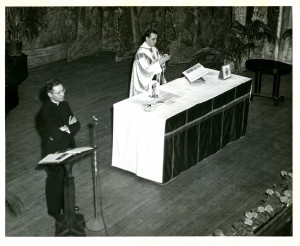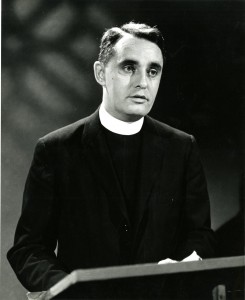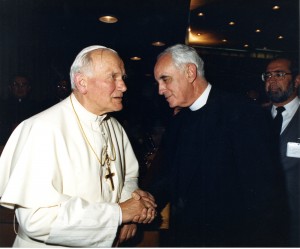
This week’s post is guest authored by Chelsy Tracz, a CUA graduate student in Theology.
The twentieth century witnessed an explosion in the growth, development, power and influence of various forms of media in our world. While we might be most familiar with the digital revolution—which we, as archivists, are working to take full advantage of—the explosion of radio and television preceded the rise of the internet.
The development of radio and the advent of television didn’t just change the landscape of American popular culture, but had such influence that even the Catholic Church had to reckon with this new form of communication.
The highly influential Msgr. Frederick Richard McManus (1923-2005) was one of the many leaders of the Church that offered guidance about these new forms of media. Having received both his bachelor’s and doctoral degrees from The Catholic University of America (CUA), he later returned to CUA, serving as the Dean of Canon Law from 1958 to 1993. McManus is most notable for his leadership in the twentieth century Liturgical Movement and for his role as peritus (or expert) on Sacred Liturgy at the Second Vatican Council. He would prove to be integral in implementing the reforms of Vatican II in the liturgy of the United States, celebrating the first official English-language Mass in 1964.

The Council produced sixteen total documents between the years 1963 and 1965. The first was Sacrosanctum concilium in 1963 on which McManus served as peritus. In the same year, the Council issued its second document, a decree on social communications, Inter mirifica, which demanded that “all the children of the Church should join, without delay and with the greatest effort in a common work to make effective use of the media of social communication in various apostolic endeavors, as circumstances and conditions demand.” (IM 13)
One such endeavor was the broadcast of the Holy Sacrifice of the Mass on television and radio.
The McManus papers at CUA contains his notes on the proper rubrics for doing just that. He briefly lists random concerns and considerations that should be included in any broadcast of the Mass. These comments include everything from who should be consulted, to the Mass setting and the inclusion of the liturgical seasons. McManus strongly advises against “the canonization of bad taste” which might portray a church or altar resembling “a living room with chintz curtains.”
The McManus papers also houses several scripts he used to broadcast the liturgy. These read almost like a sports report with a detailed play-by-play and added commentary. In a present-day context, I found the scripts entertaining as I imagined McManus’s commentary being dubbed over the actual audio of the Mass; however, McManus firmly believed that these details and explanations could greatly benefit the faithful as a tool for catechesis, helping to draw listeners and viewers into a deeper understanding and appreciation for the liturgy. His scripts address the significance of different actions, symbols and prayers that I’m sure have plagued many a mind in the pews during Sunday Mass.

McManus would go on to serve as member of the task group of the USCCB’s Secretariat for the Liturgy that developed the guidelines for televising the liturgy. Our collection contains McManus’s comments on the first and second draft of these guidelines, as well as many of the supporting documents that guided the Secretariat in writing these rubrics.
While television and radio are familiar territory for us, the Church had to address these new forms of communication as they became available, prevalent and popular. Msgr. Frederick Richard McManus helped to guide the Church in the use of this new media in its most sacred sphere—the liturgy.
